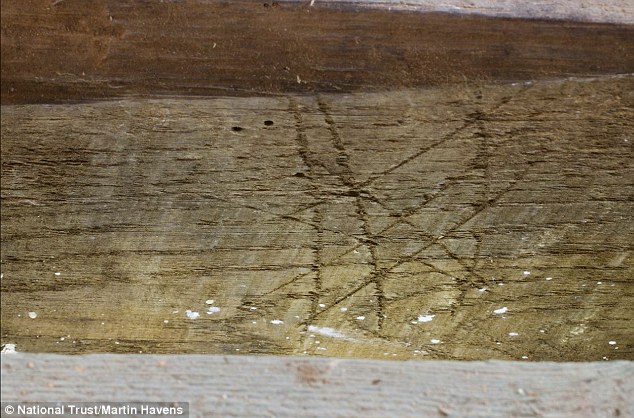It looks like you're using an Ad Blocker.
Please white-list or disable AboveTopSecret.com in your ad-blocking tool.
Thank you.
Some features of ATS will be disabled while you continue to use an ad-blocker.
1
share:
witch marks newly discovered under 17th-century floorboards at Knole
Never heard of such a thing, just fascinating
www.theguardian.com...
Vs and Ws invoking the protection of the Virgin Mary, kinda like a spell itself now isn't it? very interesting.

Here be witchmarks! Carvings to protect James I after 1605 Gunpowder Plot found in Kent
rt.com...
The book he wrote.
Daemonologie. by King of England James I
www.gutenberg.org...
internetshakespeare.uvic.ca...;jsessionid=B83D3A8FE007F347B978E70B248D926C
whoops I'm not going to read this, I don't think so anyway.
Never heard of such a thing, just fascinating
www.theguardian.com...
The marks, made in the enormous oak beams on the sides facing the fireplace – for the superstitious, a known weak spot in defence against witches – include scorch marks made with a candle flame before the timbers were installed, carved tangles of Vs and Ws invoking the protection of the Virgin Mary, and maze-like marks known as demon traps, intended to trap the malevolent spirits which would follow the lines and be unable to find their way back out.
Vs and Ws invoking the protection of the Virgin Mary, kinda like a spell itself now isn't it? very interesting.

Here be witchmarks! Carvings to protect James I after 1605 Gunpowder Plot found in Kent
rt.com...
The book he wrote.
Daemonologie. by King of England James I
www.gutenberg.org...
internetshakespeare.uvic.ca...;jsessionid=B83D3A8FE007F347B978E70B248D926C
From the Daemonologie In the dialogue, the authority-figure, Epistemon, explains what kinds of "unlawful charms, without natural causes" are to be considered witchcraft: I mean by such kind of charms as commonly daft wives use, for healing of forspoken [bewitched] goods, for preserving them from evil eyes, by knitting . . . sundry kinds of herbs to the hair or tails of the goods; by curing the worm, by stemming of blood, by healing of horse-crooks, . . . or doing of such like innumerable things by words, without applying anything meet to the part offended, as mediciners do. The crucial test is that the charm works at a distance, unlike accepted medicine; it is witchcraft even when its purpose is good. In all fairness, it seems likely that by the time Macbeth was written James had become rather more skeptical; he continually warned his judges not to allow themselves to be deceived.
whoops I'm not going to read this, I don't think so anyway.
edit on 093030p://bWednesday2014 by Stormdancer777 because: (no reason
given)
edit on 103030p://bWednesday2014 by Stormdancer777 because: (no reason given)
oops might as well close it, see it has already been posted, thanks
new topics
-
This should be plastered all over the airwaves
Mainstream News: 3 hours ago -
Oh, Good Gosh. “Kremlin Warns Stay Away from Greenland.”
World War Three: 4 hours ago -
Archbisop Vigano Warns of Deep State and Deep Church
New World Order: 5 hours ago -
A Flash of Beauty: Bigfoot Revealed ( documentary )
Cryptozoology: 10 hours ago
1
